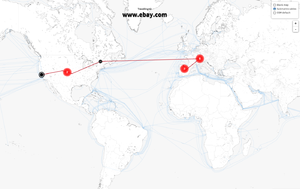User:Roelroscama/gradreserach
Tentative Title
The Providers?
Introduction
During the previous year at the PZI I have been focused on the infrastructure of the internet. I think as a graduation project I will continue this research and make a publication about it (TELEWAR style, both a visual and a written essay). I would like to continue the playful research and design that I used for Telewar, combined with the technical knowledge I gained from Border Check to produce this project. I think the thesis and the final project will be more or less the same thing.
In this case I will look both at the infrastructure and the people that run it. I'm not entirely sure how to go about this. But I think the way they represent themselves is quite interesting to look at.
Relation to previous practice
During the previous year I worked on two projects that will serve as a point of departure. Telewar was a publication on the mediated nature of war, it described both the current drone war and the then reignited conflict between Israel and Hamas where social media played a large role. Telewar had a very strong visual component in which we tried to gain a deeper understanding of the people behind the drones by examining the iconography of military badges.
The other project, Border Check, developed out of working with tracerouting and investigating the geopolitics of the internet. Border Check is a browser extension that shows how you connect to websites around the internet. It will show you which states and networks you pass through. Each of these states or networks might have different views on whether they can retain or monitor your data.
Key Words
infrastructure history people in a system symbols/semiotics self-representation networks of control
Relation to a larger context
Some artists and projects I find interesting in this relation: Melle Smets de Snelweg Safari, about vernacular highway culture. Trevor Paglen, on secretive infrastructures. Metahaven's design/image centric approach to infrastructure.
There is this thing called 'stacktivism' which seems to be to the infrastructure discussion what 'The New Aesthetic' was to digitally native aesthetics. It's dealing with questions of determinism in net infrastructure and the geopolitics of it. I'm not too enthousiastic about it but people active within this context could be considered peers.
Practical Steps
Do a visual research into how members of (on-line)communities of network administrators represent themselves.
Ask technical questions on these forums designed to get answers that might reveal a bit about the way they perceive a network in terms of politics (should everyone be given as much rights on the machine? If so why? What are the hirarchies?)
Bibliotecha will be set up within the school and I will experiment to see how it's use is built into the system, eg. do certain systems illicit certain behaviours?
Go to Are You Being Served?
References
Protocol, Alexander Galloway Victorian Internet, Tom Standage Wendy Chun, Control Freedom Postscript on the societies of control, gilles deleuze
Descriptions of previous work
Border Check
Border Check (BC) is a browser extension that maps how your data moves across the internet’s infrastructure while you surf the web. It will show you through which countries and networks you surf to illustrate the physical and political realities of the internet’s infrastructur using free software tools.
Telewar
Telewar is a research project by The Force of Freedom and Dave Young on the topic of drone warfare. The project was initiated in november 2012 during a three week residency at Upominki in Rotterdam. The result of the residency was a self-published booklet containing an heavily illustrated essay. In it we try to make some sense of the drone warfare phenomenon by looking at how the users of military UAVs represent themselves both officially and unofficially. This is done by examining places, images or artifacts where an official and regulated narrative on drones intersects with with a more spontaneous and uncensored one. Examples include public facebook profiles of UAV squadrons, the online second hand market for drone-related insigna and offical documents conerning the topic.
The latest iteration of the project consists of two film loops. One is a taxonomy of UAV uniform patches. In this film a collection of patches is categorized and classified into four distinct topics, animals, flight hours, mythology and the earth as a grid. By making this taxonomy and studying the symbols for their connotation and their history the viewer gets a better insight in how UAV operators view themselves and the world. The second film is a lexicon of drone terminology. By juxtaposing military jargon with images it tries to scrutinize the pentagon euphemisms that are used to talk about UAVs and the Global War on Terror.

Freekea Workshop


